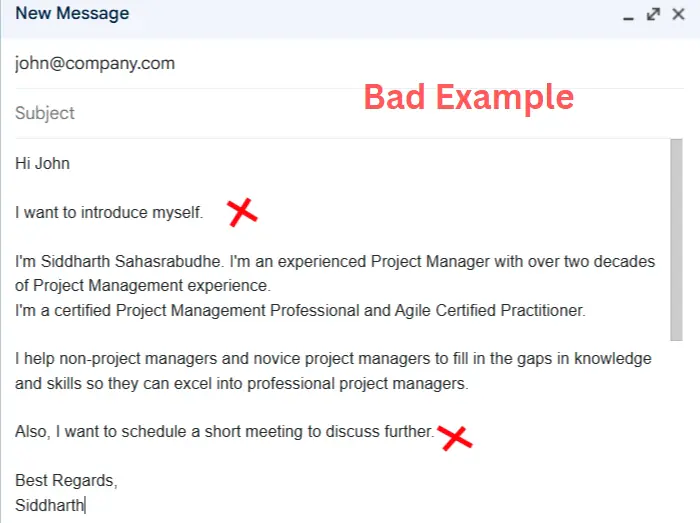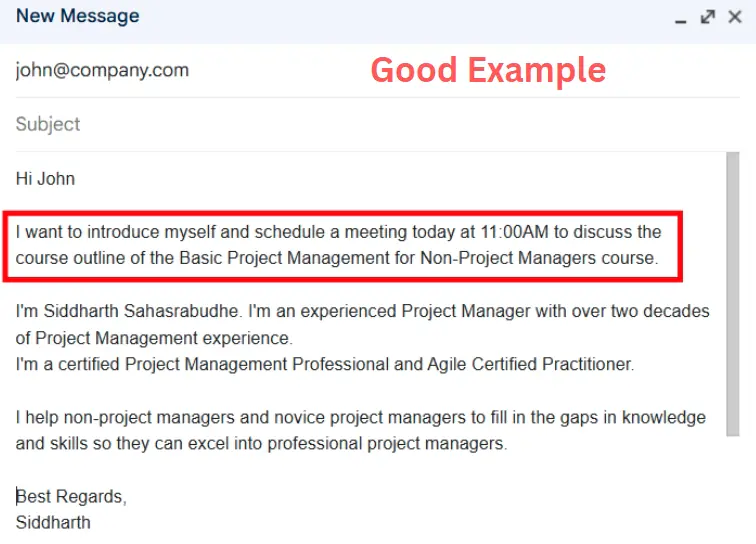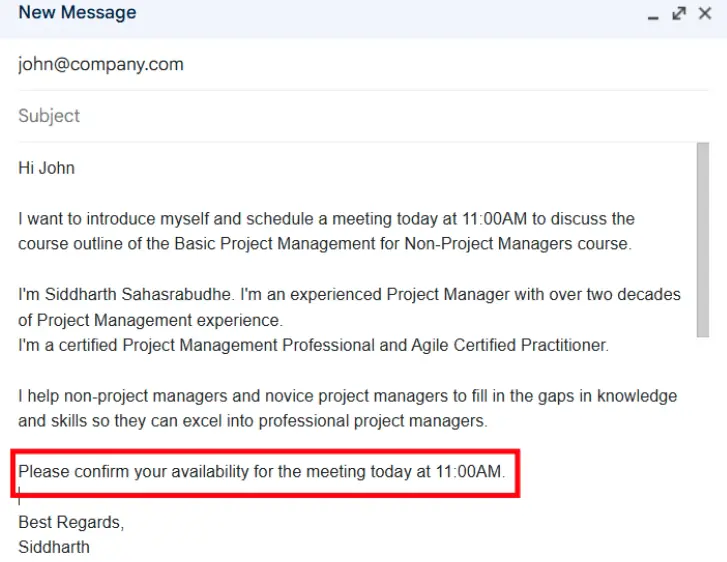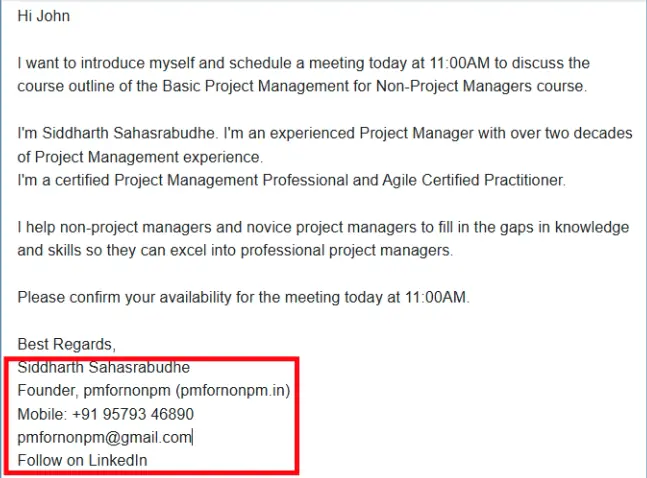How many project management emails do you write a day?
Do you always get desired response to your emails?
Email communication is a cornerstone of project management because it provides a formal, documented, and efficient way to share information, coordinate tasks, and keep stakeholders aligned.
On the projects, Emails serve as a written record of communications, decisions, and agreements, which can be referenced later if needed.
By following best practices for email communication, project managers can enhance their effectiveness and ensure that their messages are understood and acted upon appropriately.
In this article, I have shared 8 rules to professional email communication. If you follow these rules, chances are high that your emails will get noticed and acted upon.
Rule #1 – Write Professional Email Title that Rings Bell
Which Title is better?
Subject: Meeting Notes
Or
Subject: New Product Launch Meeting dated 10/23- Meeting notes
Inboxes are often flooded with emails, and a compelling subject line ensures your message stands out. A strong title grabs the recipient’s attention immediately, increasing the likelihood of your email being opened.
A well-crafted subject line sets the tone for the email and conveys professionalism. Your subject line should trigger an instant recall of the context of the matter you want to discuss.
Rule #2 – Address the Email Correctly
There are three address lines for email
To:
I prefer to have only one email address in this field. It is the person I want to take action or have response from. Avoid overcrowding the “To” field. If too many people are included, it can dilute responsibility and lead to inaction.
Cc:
Here you can address everyone else who needed to be informed but are not required to take action. The “Cc” field is for individuals who should be aware of the email’s content but are not directly responsible for responding or acting on it.
Bcc:
Blind Carbon Copy gives you an opportunity to address recipients that will not be shown in the email details. The “Bcc” field is useful for protecting privacy or when you want to discreetly keep someone in the loop.
Rule #3: Don’t Beat Around the Bush
Professionals are busy and often skim emails. By getting to the point immediately, you respect the recipient’s time and make it easier for them to understand the purpose of your email without reading through unnecessary details.

Starting with the main point eliminates confusion and ensures the recipient knows exactly what the email is about. This is especially important in fast-paced work environments where clarity is critical.

Rule #4 – Always end Email with Call to Action
Ending an email with a call to action (CTA) is a powerful way to ensure your email achieves its intended purpose. A CTA clearly tells the recipient what you want them to do next, making your communication more effective and actionable.

Rule #5 – One Action per Email
Include one clear action in an email.
A single action makes the purpose of the email clear and easy to understand. The recipient knows exactly what is expected of them, reducing confusion or misinterpretation.
Emails with one clear action are more likely to get a response. When recipients see a straightforward request, they can quickly decide how to act on it, rather than feeling overwhelmed by multiple tasks.
Rule #6 – Use Bullet Points or Numbered Lists in Email Body
Including bullet points in emails is a highly effective way to improve readability, clarity, and overall communication.
Large blocks of text can be overwhelming and difficult to read, especially in a professional setting where time is limited.
Bullet points break down information into smaller, digestible chunks, making it easier for the recipient to scan and understand the content quickly.
Example:
- Deadline: Friday, October 20.
- Budget: $10,000.
- Key Stakeholders: John, Sarah, and Alex.
Rule #7 – Keep the Email “Bare to The Bone”
The email should be as brief as possible.
Nowadays, with so much distraction, reading long texts is difficult. For productivity reasons, lots of managers put “difficult” emails off.
Therefore, simple and concise email makes it easier for a person to save time and prioritize the email. Make it important with only a headline, entry paragraph, and CTA.
Professionals receive dozens (or even hundreds) of emails daily. A concise email respects the recipient’s time and allows them to process the information quickly.
Rule #8 – Do You Need a Fancy Signature?
The short answer is Yes. An email signature is a key part of professional communication. It provides essential contact information, reinforces your brand, and leaves a lasting impression.
Though there are some rules here.
- Keep it simple and clean
- Include only essential information.
- Limit the number of lines to 5-7 lines of text
- Use Professional font
Here is the format you can use as a starting point.
<Name> <Last Name>
<Role Title>, <Company Name (can be a link to corporate site)>
<Mobile Phone>, <Office Phone>
<Email as a link>
<Your Social media links>

Some more Practical Tips on Email Communication
Never answer an Email when Angry. Once an email is sent, you can’t take it back. Angry emails can come across as unprofessional, emotional, or impulsive, which may harm your credibility and reputation.
Treat Email as Last Resort. If you can pick up your phone and call a person for information, please do so. This is the fastest way to get or communicate the information. After your call don’t forget to use emails to verify and confirm agreements and actions. Remember that it leaves everlasting trails and may be used years after.
Write in a Professional Tone. No matter whom you are sending an email, your tone should be professional and calm. No jokes, no sarcasm, no commanding, or yelling. The professional and calm tone has a greater impact on the recipient. It leaves little space to avoid your questions or requests.
Proofread Everything You Write. Avoid spelling mistakes, common grammatical mistakes that may change the meaning of a sentence.
Attach Relevant Files or Links. Providing all necessary resources in one email saves time and avoids back-and-forth communication.
Summary
Email communication is essential for project management because it ensuresclarity, accountability, and documentation. By using email effectively, you can keep your team aligned, stakeholders informed, and your project on track.
Further Resources
Interested in learning Microsoft Projects. Check out my 18 HOURS LIVE ONLINE course inMicrosoft Projects for Absolute Beginners.




